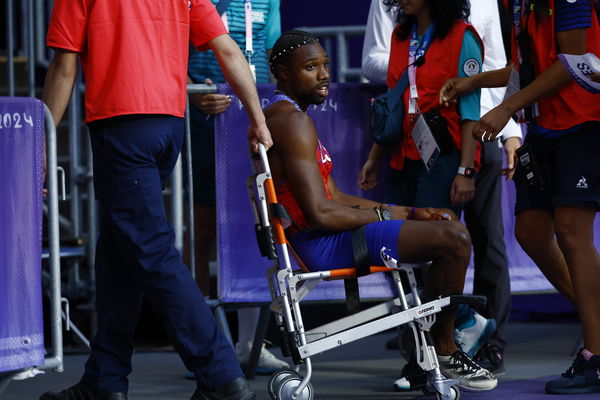
via Reuters
Paris 2024 Olympics – Athletics – Men’s 200m Final – Stade de France, Saint-Denis, France – August 08, 2024. Noah Lyles of United States receives medical attention after winning bronze. REUTERS/Sarah Meyssonnier

via Reuters
Paris 2024 Olympics – Athletics – Men’s 200m Final – Stade de France, Saint-Denis, France – August 08, 2024. Noah Lyles of United States receives medical attention after winning bronze. REUTERS/Sarah Meyssonnier
On the night of August 9, 2024, Noah Lyles stood on the track, his chest heaving as he struggled to catch his breath. The world saw an athlete who had just earned third place in the 200-meter final. What they didn’t see was the battle raging within him—a battle not against his competitors but against COVID-19. Two days earlier, Lyles woke up feeling the familiar signs of illness: chills, a sore throat, and aching muscles.
“I woke up in the middle of the night feeling chills, aching, and a sore throat,” he later revealed. “Those were the symptoms I always got right before COVID.” A test confirmed his fears: he had contracted the virus. The diagnosis immediately changed everything. Lyles was moved from the Olympic Village to a nearby hotel, where he was placed in isolation. But even as his body struggled, his resolve remained unshaken.
Determined not to let the virus derail his Olympic dream, Lyles turned to every available resource, including Paxlovid, to manage his symptoms. “I still wanted to run,” he shared. “They said it was still possible.” Knowing he couldn’t rely on reserves of energy, Lyles devised a plan: go all out from the start. “I knew if I wanted to come out here and win, I had to give everything I had from the get-go. I didn’t have any time to save energy,” he explained. He kept his condition a secret, choosing to focus on what lay ahead.
ADVERTISEMENT
Article continues below this ad
Poll of the day
Poll 1 of 5
AD



For a moment, the stadium fell silent. His mother, Caine Bishop, was in the stands, watching her son, and what she saw shook her to the core. “This was one of the scariest moments of my life!” she wrote on Instagram later. “Watching my son hold his chest gasping for air while the stadium security refused to call a doctor as I begged them to send him help… No parent should ever have to experience this feeling of helplessness!”
Four months later, Noah Lyles sat down with Rai Benjamin and Grant Holloway on the “Beyond The Records Podcast” on December 13th, 2024, to reveal what happened after that terrifying moment at the Paris Olympics. Lyles shared the shocking details of his post-race ordeal, “For a little bit, I was okay, and I was walking around, and then my chest got super tight. All of a sudden, I was struggling to breathe, and I was already using my inhaler. But, you know, they wouldn’t let the US doctor come on to help me, so I was out there for like five minutes, just flailing on the ground.”
Amid this chaos, Lyles’ mom was desperately trying to reach him. “We saw Mama trying to jump over the stairs. Yeah, my mom was in a panic,” Lyles recalled. The scene was intense, and as he was taken to safety, Lyles recalled the surreal moment of being wheeled away. “They took me underneath, and that’s where you saw me in the wheelchair,” he said.
“I remember being wheeled away, and here comes an Olympic official saying, ‘So, you obstructed the piece before the race, and we’re going to fine you.” By the end, Lyles was helped by the NBC Olympics team and USA Track & Field staff. But if Lyles had known he had COVID before the race even started, why was is still allowed to compete in the first place?
Did COVID-19 change the rules at the Paris Olympics? Noah Lyles’ controversial race explained
At the Paris Olympics, COVID-19 was still a factor, but the rules were different compared to the past two Games in Tokyo and Beijing. There was no mandatory testing for athletes, and, 19 athletes, including some British and Australian swimmers, tested positive before the competition and were still allowed to compete. While masks were encouraged for anyone feeling unwell, they weren’t mandatory.

ADVERTISEMENT
Article continues below this ad
The U.S. track federation, along with the U.S. Olympic and Paralympic Committee, followed the official Olympic and CDC guidelines and supported Lyles’ decision to race despite being COVID-positive. “After a thorough medical evaluation, Noah chose to compete tonight,” they said in a statement. “We respect his decision and will continue to monitor his condition closely.”
It wasn’t the first time COVID had impacted his Olympic journey, he also struggled with the emotional challenges during the Tokyo Games, where the pandemic and the empty stands took a toll on his mental health. While Lyles pushed through and competed in the 200m final, there were questions about the risk of spreading COVID, especially in a sport that’s typically non-contact.
ADVERTISEMENT
Article continues below this ad
Lyles was seen warming up for the final in a mask, and 200m champion Letsile Tebogo, who won the 200m Olympics gold, noticed something seemed off but didn’t know Lyles had tested positive. Lyles made an effort to stay away from others during the race but even with his precautions, the lingering question remained: Was it worth the risk to compete while COVID-positive? Comment below and let us know!
Top Stories
ADVERTISEMENT
ADVERTISEMENT
ADVERTISEMENT
ADVERTISEMENT

